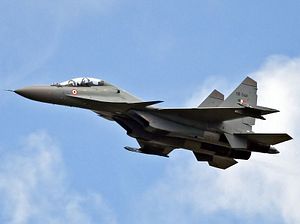The Indian Air Force (IAF) stood up its first permanent Su-30MKI squadron, 222 Squadron also known as the ‘Tigersharks’, in Thanjavur, Tamil Nadu in southern Indian on January 20, according to local media reports.
The commissioning ceremony of the new IAF unit was attended by India’s new Chief of Defense Staff, General Bipin Rawat, and IAF chief, Air Chief Marshal RKS Bhadauria.
The squadron will initially consist of four to six Sukhoi Su-30MKI fighters and is slated to reach its full complement of 18 aircraft by early 2021. Eight of the squadron’s 18 Su-30MKIs are set to be armed with the air-launched BrahMos-A supersonic cruise missile.
The BrahMos-A is expected to be cleared for operational service with the IAF later this year. Following a successful test launch of the missile in December 2019, the IAF announced that the integration of the BrahMos-A on the SU-30MKI had been completed.
India’s Defense Research and Development Organization (DRDO) and the IAF last test fired a BrahMos-A from a Sukhoi Su-30MKI fighter on May 22, 2019. The missile was first flight tested from a Sukhhoi Su-30MKI in November 2017 over the Bay of Bengal.
Only two IAF Su-30 MKI fighters have been converted to carry the air-launched variant of the BrahMos to date. The Indian government approved the integration of the BrahMos-A into the Su-30MKI in 2016 with integration kicking off at the end of 2017. The government decided to expedite the integration of the missile last year following the Balakot air strikes and the ensuing India-Pakistan military standoff.
A total of 42 Su-30 MKIs are slated to be upgraded to carry the 2.5-ton supersonic cruise missile. According to 2019 press release by the Indian Ministry of Defense (MoD), “the integration of the weapon on the aircraft was a very complex process involving mechanical, electrical and software modifications on aircraft.”
There also have been reports that the integration process includes reinforcing the Su-30MKI’s undercarriage and installing hardened electronic circuitry to withstand the electromagnetic pulses of a nuclear blast as the BrahMos-A missile is thought to be dual-capable, although the Indian MoD has repeatedly denied any plans to modify the cruise missile to carry a nuclear payload.
The BrahMos-A has an estimated operational range of around 400 kilometers and can be dropped from 500 to 14,000 meters (1,640 to 46,000 feet) by a Su-30MKI. The BrahMos-As of 222 Squadron have reportedly been designated for anti-surface warfare missions.
The cruise missile, named after the Brahmaputra River in India and the Moskva River in Russia, is an upgraded variant of the Russian-made P-800 Oniks over-the-horizon supersonic anti-ship cruise missile. It is considered to be one of the world’s fastest cruise missiles.
Each Su-30 MKI can reportedly carry one missile in a transport launch canister. The IAF is expected to stand up a total of two Su-30MKI squadrons armed with BrahMos-A missiles. Overall, the IAF plans procure 200 BrahMos-A missiles.

































